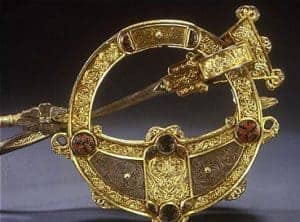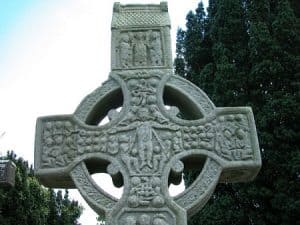1000 BCE –
Celtic art is not characterized only by the stylized throwbacks you see at modern-day festivals or in shops that sell nouveau Irish merchandise. In fact, the Celts did not arise in Ireland, but in Central Europe.
Celtic art is a broad movement in the history of art that is really three movements attributed to peoples of different times, locations, and cultural values, but that share a heritage.
The overarching theme of Celtic art is one of symbolism coupled with non-linear, geometric design. Most surviving pieces are those that were forged from metal or carved in stone, so scholars cannot be sure that all typical art from the period is represented in what still remains today.
Art History: Celtic Art Origins and Historical Importance:

Pinning down the exact dates of the origins of Celtic art is debatable as archaeologists put the beginnings of Celtic culture at 1000 BC while art historians generally begin with the art of the La Tene period in the 5th century BC.
Looking at the archeologist’s model, the arts and crafts of the Celts begin with the Hallstatt Culture which was centered in Austria but spread over a larger region. The Hallstatt’s were prolific traders in mined minerals and were a wealthy civilization. With bronze and iron age metal art working technology, they created weaponry and tools in iron and decorative pieces in bronze.
Being a mobile society, they had been influenced by Mycenaean art as well as other Mediterranean styles. Some silver and gold pieces existed, but not many.
“The Green Man has also become synonymous with Cernunnos, the Celtic horned God, often portrayed in Celtic art as part man, part stag, who roams the greenwood wild and free. He is a character of strength and power, but often sadly mistaken for the devil by the Christian fraternity due to his horned appearance.” – Carole Carlton
Motifs of the Hallstatt era were animals, spirals, and geometric designs on weaponry and adornments. They favored birds, knotwork, and fretwork. They employed color, and in unpainted pottery, they used a polychrome technique. Weaponry and other tools were shaped according to both aesthetics and usefulness, as in the case of dual-sided curved axes, or curved swords.

The La Tene era is the beginning point as far as art historians are concerned and is chiefly recognizable by its swirling curvilinear patterns. The movement began in what is now Switzerland, and its influence is still felt today. The Celts had by this time moved northward into Switzerland from the Danube River in Austria and the Rhine region of France.
La Tene artists worked quite a bit in gold, especially in jewelry and other personal adornment. Most surviving art from this period in Celtic art is made from gold, iron, bronze, and other metals. Decorated with scrollwork that is reminiscent of foliage and ivies, these metallic objects include vessels, bowls, weapons, and sculpture in addition to the jewelry mentioned.
“And what can a simple girl do? (Henry)I was told, by my father, of St. Mary of Aragon who single-handedly brought down an entire Saracen army with nothing more than her faith in God. He also spoke of an ancient Celtic queen named Boudicca who brought Rome to her knees and burned London to the ground. He oft said that a woman was far more deadly as an enemy than a man, because men lead with their heads and women with their hearts. You can argue and win against another’s head, but never against her heart. (Callie)”. – Kinley MacGregor
The Celts had influenced the Irish and British in the beginning of this era and moved into these lands during this period. Irish La Tene art flourished after Rome absorbed the Celtic tribes of other lands. The Irish were left alone and the artistic style survived there without much Roman influence. It is in Ireland that most Celtic stonework was created, as in the tradition of the Celtic High Crosses.

Insular Celtic art was that of the British Isles, particularly Ireland. It is from these works that we derive much of what the general public would recognize as Celtic art. Monastic traditions in Ireland brought a Christian bent to the Celtic arts and vice versa. The movement produced works like the famous Book of Kells and other illuminations, the previously mentioned High Crosses, and metalwork in the form of chalices and other objects.
Scotland and Wales also contributed to insular art. Wales added to the library of illuminated manuscripts and Scotland created stone sculptures with high Pictish influence.
Celtic Art Key Highlights:
- The Celts added to the art they produced with pieces taken from the places they visited. One chieftain was buried in a Chinese silk robe.
- “Cult wagons” fashioned from bronze were large trolleys in which were standing figures. A large bowl that may have been meant to hold religious offerings was atop a shaft at the center of the piece.
- The warring drinking nature of the Celts can be seen in what they chose to produce, and there are a bevy of large, elaborate drinking vessels and quite a lot of weaponry.
- The Celts created coins beginning in the 3rd Century BC. Initial styles borrowed from that of the Greeks and Romans and then later became more Celtic in design.
- The modern Celtic Revival began around the time of the discovery of the Tara Brooch in 1850. Brooches soared in popularity and the revival jumped to the United States where architecture and grave markers began to display Celtic motifs.
- While the Celts did produce pottery, it was not on the level of other cultures of the time and was used mostly for mundane daily purposes. They reserved metals for making their finer pieces.
Celtic Art Top Works:
- Battersea Shield
- Tara Brooch
- Wandsworth Shield-boss
- Staffordshire Moorlands pan
- The Great Torc – Snettisham Hoard
- Hochdorf Chieftain’s Grave – various objects
- Muiredach’s High Cross
- Moylough Belt Shrine
- Gundestrup Cauldron
[html_block id=”9712″]
[html_block id=”9474″]

